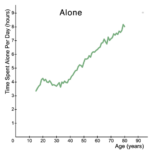 The older we get, the more time we spend alone. But just how big of a deal is loneliness?
The older we get, the more time we spend alone. But just how big of a deal is loneliness?
While it may seem trivial compared to other challenges faced by older adults, health experts warn that loneliness can be as damaging as smoking twelve cigarettes per day.
With tens of millions of seniors affected, acute loneliness and seclusion in senior cohorts have reached epidemic levels.
To make matters even worse, Covid-19 exacerbated these already-pervasive isolation issues, creating ripple effects for years to come. The bottom line is that loneliness is a pressing problem for a considerable percentage of the population and hasn’t been addressed in meaningful, systemic ways.
What is Loneliness?
Dr. Stephanie Cacioppo, Assistant Professor of Psychiatry and Behavioral Neuroscience at UChicago, defines loneliness as “a state of mind characterized by a dissociation between what an individual wants or expects from a relationship and what that individual experiences in that relationship.”
Jumping off from this definition, loneliness can be induced by a lack of physical presence or connection while physically present. When applying this perspective to the experiences of older adults, it becomes clear that the degradation of objective social isolation and subjective loneliness are both at play.
Dr. Cacioppo continues by saying that “loneliness is a state of mind; being physically alone is not a necessary nor a sufficient condition to experience loneliness. One can experience a lonely state of mind while being with people at work, at home, or even in a marriage. Income, education, gender, and ethnicity don’t necessarily protect you from loneliness, and it is contagious.”
The Health Effects of Loneliness
The research tying loneliness and social isolation to a litany of health conditions continues to pile up, finding links to heart disease, obesity, compromised immune systems, depression and anxiety, cognitive disorders, high blood pressure, dementia, Alzheimer’s, and death.
Loneliness may be the subjective distress caused by a lack of connection and social isolation, but even emotional distress can have adverse, objective outcomes.
But what exactly is happening physiologically to a person undergoing chronic loneliness?
Dr. Steve Cole, PH.D. and director of the Social Genomics Core Lab at the University of California, elucidates why loneliness takes such a severe toll on our health. He explains that “loneliness acts as a fertilizer for other diseases. The biology of loneliness can accelerate the buildup of plaque in arteries, help cancer cells grow and spread, and promote inflammation in the brain leading to Alzheimer’s disease. Loneliness promotes several different types of wear and tear on the body.”
Loneliness by the Numbers
A 2020 report, Loneliness from Young Adulthood to Old Age: Explaining Age Differences in Loneliness, identified four primary factors leading to loneliness:
- Living alone
- Poor health
- Infrequent socializing
- Being partnerless
Older cohorts are more likely to meet these conditions for loneliness than any other age bracket simply because those conditions often represent the norm of elderly lifestyles.
However, with one-in-three Americans experiencing loneliness regularly, the statistics show that younger demographics are lonely just as much or more than their older counterparts. This can be attributed to the fact that virtual relationships characterize many relationships of younger people and that older people have more time to socialize and spend meaningful time with others in person.


